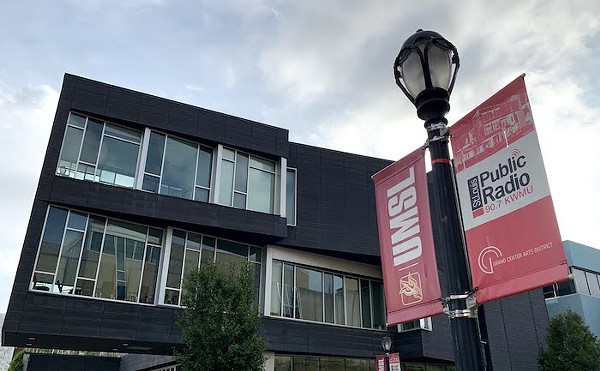In the fall of 2004, Woolsey's passion for sports prompted him to sit down with Harry Rich, the then-chief financial officer of the St. Louis Public School District. Woolsey wanted to know how he could help the cash-strapped district improve its athletic facilities.
"'What do you need? What can I do?'" he remembers asking.
During his meeting with Rich, Woolsey learned that only four of the city's ten high schools have suitable football fields for actual games, and that soccer practices are often relegated to city parks. Only Vashon High School has showers for its gridiron squad. During football games at Gateway High School, players are forced to share portable toilets with fans.
"And the city hasn't hosted a state track meet in 30 years," Woolsey fumes. "That's ridiculous."
In 1963 Woolsey attended Olympic trials for track and field at St. Louis' Public Schools Stadium. In the late '60s, the facility was razed to make way for housing.
"There used to be this rich tradition of schools competing at a central location," Woolsey says.
Last year Woolsey formed a nonprofit group called the Multipurpose Stadium Project, and he enlisted the support of the St. Louis Rams, who collaborate with area schools on numerous educational and athletic endeavors. Woolsey and Michael Yarborough, the team's director of community outreach, proceeded to spend hundreds of hours developing a plan for a 2,000-seat stadium, complete with artificial turf for football, soccer, track and field, and lacrosse.
The $8 million complex, as Woolsey envisioned it, would be privately funded and operated, and its board of directors would rent out the venue to non-school entities to raise money for long-term maintenance.
"The idea is to centralize costs and to include everyone," Woolsey explains.
He managed to convince the Kwame Building Group to sign on as construction manager and enlisted Mackey Mitchell Associates, a St. Louis architecture firm, to design the facility at no cost. In May 2005, Woolsey and the Rams' Yarborough presented the plans to the St. Louis School Board and Superintendent Creg Williams — and received unanimous endorsement.
In September Barbara Geisman, the city's deputy mayor of development, promised Woolsey that the city would lease or transfer to his nonprofit eighteen acres of land in Fairgrounds Park. "Feel free to proceed with vigor," Geisman wrote in an e-mail to Woolsey.
"This stadium is going to be a tremendous boost in the arm to north St. Louis," enthuses Tony Thompson, owner of Kwame Building Group.
Adds Woolsey: "There's nothing like it nationally."
Woolsey's Multipurpose Stadium Project planned to break ground this September and open in the fall of 2007. Everything seemed to be in place, with surveying and soil investigations set to begin three weeks ago.
Instead, Woolsey was forced to delay the project indefinitely, because the Rams weren't yet ready to provide an unspecified amount of seed money.
"We can't go forward without the Rams or another corporate sponsor," Woolsey laments.
Why the team's sudden about-face?
"Our real allegiance, more than anything, is with the superintendent and his grand plan," explains Rams executive vice president Bob Wallace. "We're waiting for some direction from him. We want to support what he's doing, not try to tell him what to do."
Still, Wallace adds that the Rams continue to back the Multipurpose Stadium Project but feel "stuck in the middle" between Williams, Woolsey and PHL, Inc., a group of area businessmen who last year began repairing existing athletic fields at no cost to the district.
"We'd like to get these two groups to work together, with the district," Wallace says. "We feel we can be a convening force."
PHL, Inc.'s vice president Rick Veatch applauds Woolsey's efforts but thinks the two entities can exist separately. "Having a big, rallying, central stadium would be wonderful, but that's not our objective. It would be a complement to what we're doing."
Creg Williams, however, says he doesn't understand why Woolsey's project stalled and insists that he still fully supports it. "These groups and these individuals are going to work together to figure out how to raise that money," Williams says. "And when that's done, we're all going to stand side by side and cut that ribbon together. Anything contrary to that is just simply not right."
The superintendent adds that he has other ideas for improving the district's sports fields, which he plans to reveal later this month.
"A part of my strategic plan will talk about how to create an opportunity for multiple stadiums down the line, over the next five to six years," Williams says, citing private donations and a bond issue as possible revenue streams for building the fields.
Although St. Louis voters have approved every school bond issue that's come before them in the past fifteen years, Kwame's Thompson calls the chances of building new athletic stadiums with tax dollars "a tall order," what with the district facing a $25 million deficit.
Woolsey, meanwhile, is impatient and says he's tired of the "atrocious" conditions at local high school fields. "As hackneyed and old-fashioned as it sounds, these kids can't afford to wait."





